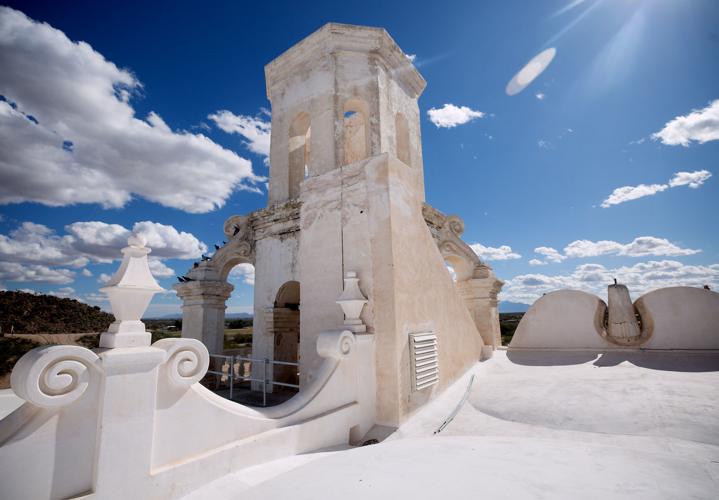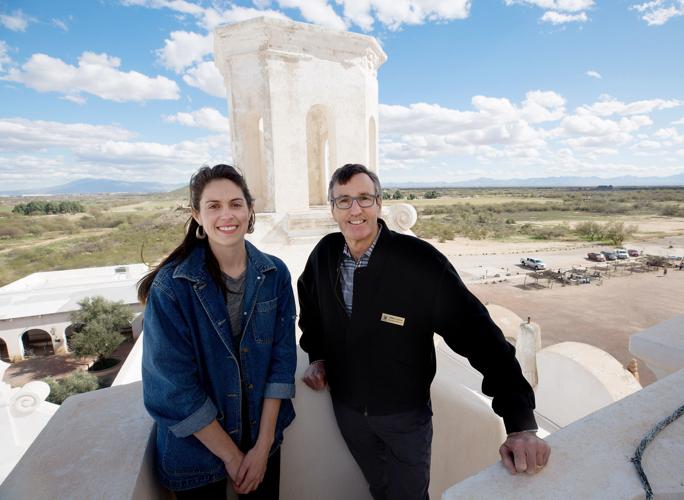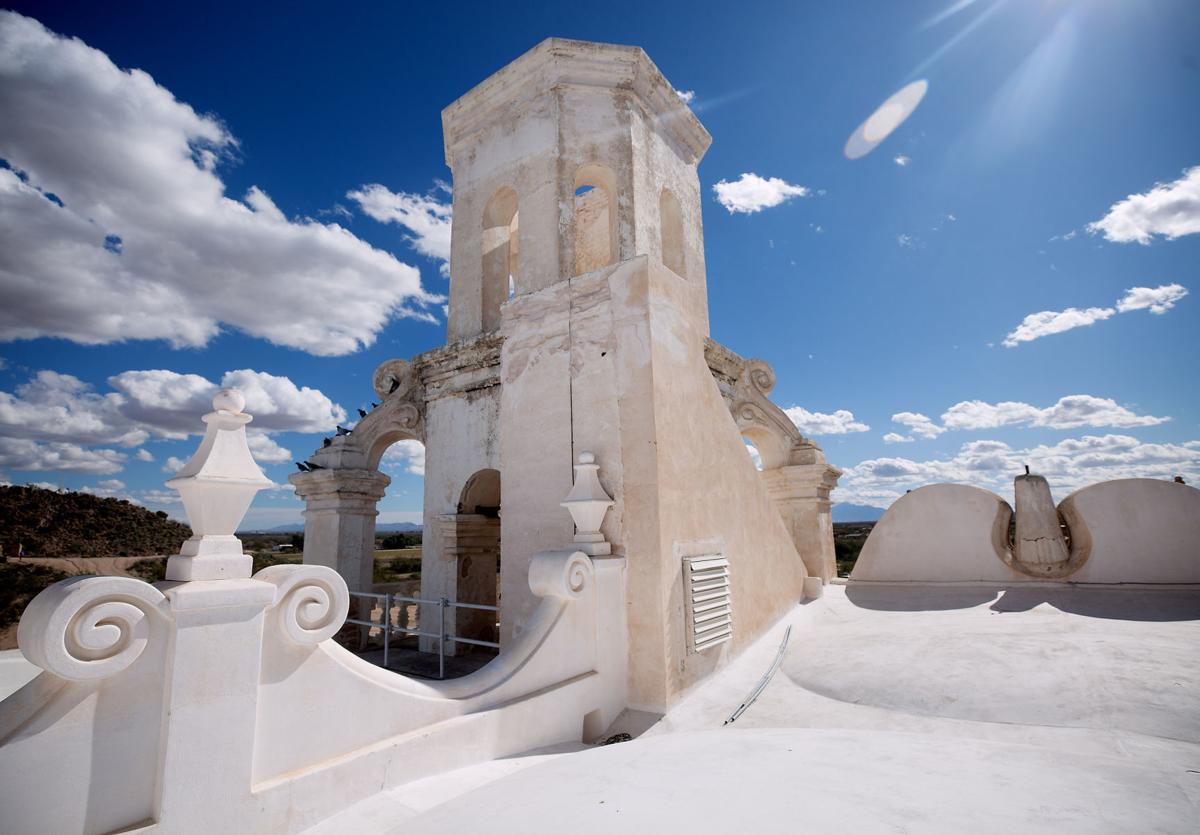The White Dove of the Desert will soon glow even brighter.
Mission San Xavier is set to undergo its biggest preservation project in more than a decade, thanks to a 2018 national grant award and a new conservation master plan now in the works.
Scaffolding could go up by late fall around the iconic church’s east tower, where workers will spend the next two years carefully removing and replacing problematic plaster around the structure’s centuries-old brick walls.
“It’s really a fix. It’s removing an incompatible product,” said Miles Green, executive director of Patronato San Xavier, the nonprofit that has overseen preservation and fundraising for Arizona’s oldest intact European structure since 1978.
During the 1940s and 1950s, the mission’s well-meaning stewards covered the building with concrete plaster made from Portland cement. But decades later, caretakers discovered that moisture trapped by the concrete plaster was being drawn by gravity down through the building, damaging the walls and interior.

Starr Herr-Cardillo, project manager, and Miles Green, executive director of Patronato San Xavier, stand in front of the east tower. The tower renovation is one of a few projects in the master plan.
Green said the problem first revealed itself in the late 1980s, when “great sheets of plaster” began falling from the ceiling, endangering visitors and the fragile artwork inside the church.
The Portland cement has since been removed from most of the structure. Only the east tower remains.
The old stuff will be replaced with new coats of traditional lime-washed plaster mixed with cactus juice, which allows the walls to breathe and release moisture.
Fickle funding has delayed tower work
Funding issues have delayed the roughly $3 million project for years, but a grant from the National Fund for Sacred Places will help finally get the work off the ground.
Patronato San Xavier was one of 13 congregations and nonprofits nationwide, and the first in Arizona, selected by the fund in 2018. The grant requires a two-to-one match, so Patronato will have to raise $500,000 of its own to get the full $250,000.
“We’re confident that we’ll be able to reach that matching amount” and then some, Green said. “This has been a project that we’ve been trying to create capacity for, and several sources of funding have vanished before our eyes.”
The west tower was covered in scaffolding from about 2003 until 2008 while its plaster was replaced. The plan at the time was to start work on the east tower as soon as the west tower was finished, using historic preservation funding from the state. Then the Great Recession hit, and the state swept that money back into its general fund, forcing a delay in the project.
In 2015, Pima County floated a bond program that would have helped pay for the renovations, but voters rejected the measure.

The view of the east tower through an archway in 1940. For the next two years, workers will be removing and replacing problematic plaster around the structure’s brick walls.
Though some work has since been done to stabilize portions of the tower’s foundation, interior and first floor, Green said about two-thirds of the job is still left to do.
One of Arizona’s “most photographed buildings”
Mission San Xavier was built between 1783 and 1797, but the east tower was never finished. Its kiln-fired adobe bricks were left unplastered, its matching dome and lantern forever absent.
“The project had been going for 14 years, and they simply ran out of money — the same kind of problem we’ve run into from time to time,” Green said.
The exposed bricks on the upper part of the tower finally received a protective coating of plaster in the early 1900s at the direction of Henry Granjon, the second Catholic Bishop of Tucson. Green said Granjon spent a lot of money, including a lot of his own money, to spruce up and expand the campus.
Past renovation efforts and future preservation priorities at the mission have been cataloged in Patronato San Xavier’s new 2020 Conservation Management Plan, set for release later this month.
The plan was produced by Tucson native Starr Herr-Cardillo, who studied geography and regional planning at the University of Arizona before earning her master’s degree in historic preservation from the University of Pennsylvania’s prestigious school of design.
“I feel very lucky,” she said. “(San Xavier) is such a special place.”
Herr-Cardillo developed the management plan in consultation with long-time San Xavier restoration architect Bob Vint and others, including historians, conservators, nearby residents and church and tribal members. She also reviewed church records, journals and photo archives dating to 1867 to chart changes in the structure.
“It’s one of the most photographed buildings in Arizona,” she said.

Exposed brick is seen on the east tower at Mission San Xavier. Moisture trapped by the concrete plaster was drawn down through the building, damaging the walls and interior.
Preserving history at a “living site”
The planning process began about 16 months ago. Herr-Cardillo described the finished product as a sort of user’s manual and reference guide for preserving the mission, which was designated as one of the first National Historic Landmarks in 1960.
The plan is now undergoing final review. The guidance it will provide is crucial, Green said. “We’re not going to be the first or the last hands to work on the preservation of this site.”
Obviously the church is the focal point, but the plan considers “the campus as a whole,” Herr-Cardillo said.
San Xavier isn’t some historical relic to be fenced off and frozen in place. It’s still an active parish that welcomes more than 200,000 visitors each year from around the world.
“It’s a living site,” Herr-Cardillo said.
Patronato San Xavier has identified some $15 million in future conservation work at the mission.
The top priorities after the east tower include preserving the building’s elaborate facade, and its doors and other original wooden elements.
“All of that has been crying out for attention,” Green said.
The facade especially needs careful documentation and so-called “conservation in place,” he said, though there are no plans to repaint it in the garish colors that some believe once served as a sort of billboard for salvation.
“The facade was really the invitation to enter the church. Had the Franciscans had neon, they would have used neon,” Green quipped.
Someday, he said, Patronato San Xavier might try to simulate what the facade once looked like by projecting colorful lights on it for nighttime visitors.

Mission San Xavier, designated as one of the first National Historic Landmarks in 1960, is an active parish that typically welcomes over 200,000 visitors a year. Visits inside the church are currently limited to 5 minutes.
National attention could help fund regular upkeep
The new conservation plan also highlights the need for more “cyclical preventative care” to extend the life of the work that has already been done and reduce the frequency and scale of big-ticket projects in the future, Herr-Cardillo said.
Right now, roughly $125,000 a year is being spent on preventative maintenance, and only about $50,000 of that funding is coming from Patronato’s permanent endowment for the mission. Ideally, Green said, they should be spending between $250,000 and $300,000 a year on upkeep.
To reach that goal, he said, Patronato is expanding its fundraising effort statewide and across the country.
Some national attention for the mission in recent years should help with that.
In addition to the grant award from the Fund for Sacred Places, San Xavier was named to the 2016 World Monuments Watch, a list of cultural heritage sites in need of international attention to ensure their future.
Green predicted that the string of Spanish missions in the U.S. and Mexico established by Father Eusebio Francisco Kino more than 300 years ago could one day win recognition as a World Heritage Site, with the White Dove of the Desert as its crown jewel.
A growing number of people outside of Tucson seem to be learning what many local residents already know about Mission San Xavier, Green said: “This is one of the nation’s top treasures.”

A 1940 photo shows the Mission San Xavier church and patio. A new conservation plan considers “the campus as a whole,” says Starr Herr-Cardillo, who produced the blueprint.

Roughly $125,000 a year is being spent on preventative maintenance at the mission. Miles Green, executive director of Patronato San Xavier, says it should ideally be double that total.










